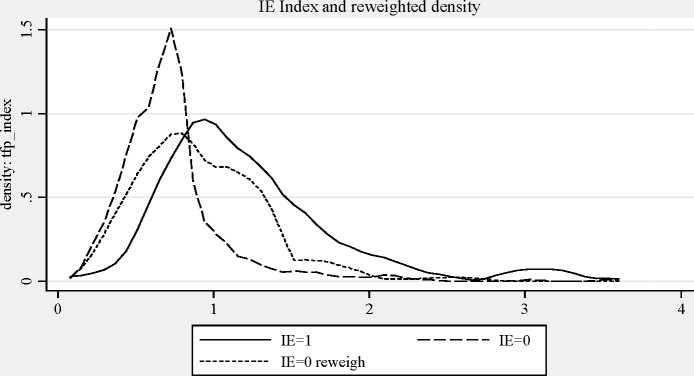by applying Bayes rule at the numerator and at the denominator, the weighting function
can be estimated using the following specification:
dF(z|X =1) Pr(X =1|z=zi) Pr(X =0)
(15)
ψ z ( Zi ) =-------------=--
z i dF(z|X =0) Pr(X =0|z=zi) Pr(X =1)
Where, Pr(X=0) and Pr(X=1) is the unconditional probability that the IE index is equal
to zero or one respectively, while Pr(X=1| z = zi) and Pr(X=0| z = zi) are the prediction
obtained from Probit estimates of the probability that X=1 or X=0, with zi as regressors45.
Figure 3 displays the estimated counterfactual density for the firms that are not involved in
trade networks. This latter density lies between the other two showing how the similarity
on firm characteristics affects the distribution of the performance variable, however it is
still always on the left of the distribution of productivity of the plants that are engaged in
trade both upstream and downstream.
Therefore after controlling for firm characteristics we still find that there is an higher
productivity advantage associated with being both an importer and an exporter.
Fig. 3 Kernel densities of TFP

45 zi is a vector that includes the same variables used to estimate equation (3)
29
More intriguing information
1. IMPROVING THE UNIVERSITY'S PERFORMANCE IN PUBLIC POLICY EDUCATION2. Migration and Technological Change in Rural Households: Complements or Substitutes?
3. The name is absent
4. Experimental Evidence of Risk Aversion in Consumer Markets: The Case of Beef Tenderness
5. Factores de alteração da composição da Despesa Pública: o caso norte-americano
6. Testing Hypotheses in an I(2) Model with Applications to the Persistent Long Swings in the Dmk/$ Rate
7. Correlation Analysis of Financial Contagion: What One Should Know Before Running a Test
8. The name is absent
9. The Veblen-Gerschenkron Effect of FDI in Mezzogiorno and East Germany
10. Elicited bid functions in (a)symmetric first-price auctions